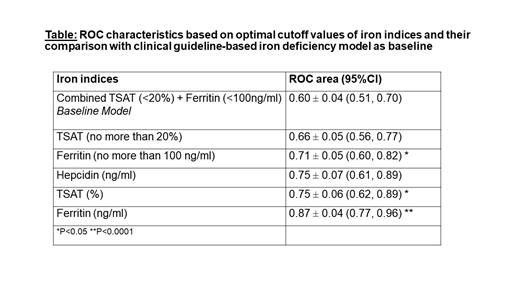Background: Iron deficiency is common in children with end-stage kidney disease (ESKD) but diagnosing iron deficiency in ESKD is challenging as serum indicators of iron stores may be influenced by inflammation and other factors. We examined which of the clinically used serum iron indices were predictive of bone marrow iron stores (the gold standard) in dialysis-dependent children and young adults with ESKD, in the setting of increased nutritional requirements and co-existing inflammation.
Methods: This cross-sectional study enrolled 71 clinically-stable children and young adults (age range 2 to 28 years) receiving dialysis, who underwent bone biopsy for CKD-mineral bone disorders between 2007 through 2011. Congenital anomalies of the kidney and urinary tract (CAKUT) and hereditary diseases (63.3%) were the main causes of renal failure, followed by primary glomerulonephritis (36.7%). Bone samples were stained with Perls' Prussian blue and independently interpreted by a pathologist unaware of the patients' iron parameters and clinical status. Staining was scored absent vs present for receiver operator curve (ROC) analysis. In ROC analysis, the ability of serum ferritin to predict bone sample iron stores was compared with serum hepcidin, transferrin saturation (TSAT), and clinical guideline-based iron deficiency cut-offs for serum iron, TSAT, and their combination. We generated optimal cut off points using the Youden's J statistic.
Results: Mean age was 17.2 ± 4.4 years, and 30% of subjects were female. Median dialysis vintage was 1.2 (IQR 0.7, 2.0) years, and 56% were supported by peritoneal dialysis. Mean hemoglobin was 12.4 ± 1.7 g/dl, and 35% were receiving iron supplementation at the time of biopsy. Based on gold standard of depleted bone iron stores, 46.5% patients were iron-deficient. As a predictor of bone marrow iron staining, serum ferritin provided the highest area under the ROC curve compared to other tests (Table), but at the usual clinical ferritin cutoff (100 ng/ml) only 22% of true iron-deficient subjects were diagnosed compared to 52% of true iron-deficient subjects using a higher optimal cutoff point for ferritin (188 ng/ml).
Conclusions: In children with ESKD, iron deficiency as determined by the gold standard bone iron staining was highly prevalent (close to 50%), and serum ferritin provided the best prediction of bone sample iron stores. Optimal ferritin cutoff for decision-making about iron administration should reflect the current relative risks and benefits of iron therapy. Future trials testing higher ferritin cut-offs and patient centered outcomes in children with ESKD are timely.
Disclosures
Ganz:Ionis Pharmaceuticals: Consultancy; Disc Medicine: Consultancy; Silarus Therapeutics: Current equity holder in private company, Membership on an entity's Board of Directors or advisory committees; Intrinsic LifeSciences: Current equity holder in private company, Membership on an entity's Board of Directors or advisory committees.


